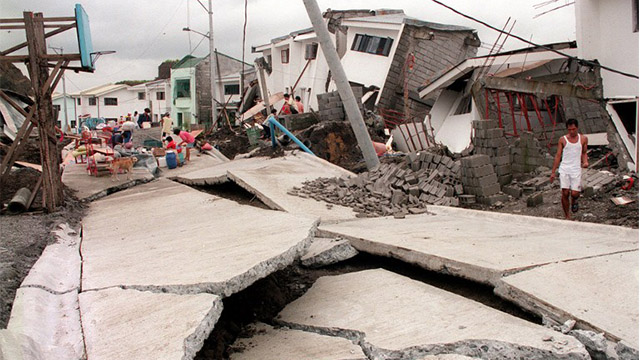 There are many types of mass wasting hazards that exist. Some are landslides, mud flows, and avalanches. In the islands of the Philippines, there are many volcanoes and mountains. This meaning, there can be a lot of opportunities for avalanches. Avalanches are when a mass of snow, ice, or rocks fall down a mountainside fairly quickly. The Philippines has also been affected by landslides. Landslides include a wide range of movements in the ground such as a deep failure of slopes.
There are many types of mass wasting hazards that exist. Some are landslides, mud flows, and avalanches. In the islands of the Philippines, there are many volcanoes and mountains. This meaning, there can be a lot of opportunities for avalanches. Avalanches are when a mass of snow, ice, or rocks fall down a mountainside fairly quickly. The Philippines has also been affected by landslides. Landslides include a wide range of movements in the ground such as a deep failure of slopes.Back in 1999, on August 3, a huge landslide hit Antipolo City tin the Philippines due to a lot of heavy rain approaching the typhoon Olga. This landslide caused a lot of damage and loss of life, it became a death trap when the foundations were filled with water and the whole complex slid down hills. The Philippines began to alert citizens and residents were told to evacuate to the nearest town once the walls of their houses began to crack. They observe and look out for sudden changes in elevation and ground movements to try and prevent citizens from being hurt. Local authorities had warned residents to evacuate hours before the hazard occurred when cracks started to appear on the roads and walls, however, houses higher up on the hill began to slide down and crush those below.
 In November of 2006, Typhoon Reming hit the Philippines causing many lives lost when mudflows from the Mayon Volcano buried multiple villages due to strong winds and heavy rains. Typhoon Reming killed almost 2,000 people, and left hundreds of more people missing.
In November of 2006, Typhoon Reming hit the Philippines causing many lives lost when mudflows from the Mayon Volcano buried multiple villages due to strong winds and heavy rains. Typhoon Reming killed almost 2,000 people, and left hundreds of more people missing.Unfortunately, you cannot prevent such a hazard. Therefore, the Philippines could only prepare for what was coming. The government made sure various tropical cyclone warnings were shown and made sure the public was well aware it was coming. Officials made sure residents living in low areas seeked higher grounds, schools closed, and multiple buildings opened up storm shelters. Emergency shelters were available for those who left their homes.

On February 17, 2006, a huge rock slide and debris avalanche happened in the Philippines leaving over 1,000 people dead. This landslide was followed by 10 days straight of heavy rain and a minor earthquake. Burying a village and an elementary school affecting over 200 students and teachers.
http://landslides.usgs.gov/learn/photos/international/2006_guinsaugon_village__leyte_island_philippines_landslide
https://en.wikipedia.org/wiki/Landslide
https://www.wsws.org/en/articles/1999/09/phil-s08.html

Mariah, after reading your post on the Philippines and their mass wasting. I found that both the Philippines and El Salvador are covered with Volcanoes that make a crucial impact on our countries; when either a typhoon or a hurricane hit. This was the case for your country in 2006 when typhoon reming scared volcano debris through surrounding villages and killed almost 2,000 residents. This was also the case in El Salvador when hurricane Ida hit in 2009 and debris from a volcano also buried the city of verapaz. The death toll was a total of 16 residents and 47 more missing. Great find.
ReplyDeleteYes, your country like Fiji and others are prone to extreme weather (heavy rains, cyclones...)and therefore, very prone to mass wasting events...you'll be busy in the next weeks!
ReplyDeleteI loved your images, particularly the first one (1999). I am curious if they rebuilt in that area (or tried to..)..